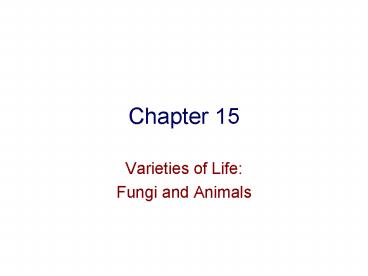Varieties of Life: - PowerPoint PPT Presentation
1 / 49
Title: Varieties of Life:
1
Chapter 15
- Varieties of Life
- Fungi and Animals
2
Seven Taxonomic Categories
- Kingdom King
- Phylum Paul
- Class Came
- Order Over
- Family For
- Genus Good
- Species Steak
3
Five Kingdoms
- Monera
- Unicellular, includes true bacteria and
cyanobacteria (blue-gree algae) - Protista
- Protozoans and algae
- Fungi
- Multicellular, heterotrophic
- Plantae
- Multicellular, autotrophic
- Animalia
- Multicellular, heterotrophic
4
Kingdom Fungi
5
Kingdom Fungi
- Four general groups of fungi
- Chytrids
- Simplest ________________________
- Can _____________________________
- Only group of fungi _____________________________
_____________________________
6
Kingdom Fungi
- Four general groups of fungi
- Chytrids
- Zygomycota
- ________________________
- ____________________________________!
7
Kingdom Fungi
- Four general groups of fungi
- Chytrids
- Zygomycota
- Basidiomycota
8
Kingdom Fungi
- Four general groups of fungi
- Chytrids
- Zygomycota
- Basidiomycota
- Ascomycota
- ___________________
- _____________________
9
Kingdom Fungi
- Simple body structure
- 1
- 2
- Cellular structure of fungi _____________________
_______________________ - _____________________________ in both body parts
10
(No Transcript)
11
Kingdom Fungi
- All fungi reproduce via ________,_______________
_______________
12
Kingdom Fungi
- Several anthropogenic uses of fungi
- ____________________
- Truffles, morels
- Fermentation
- ____________________
- Penicillin, produced by Penicillium notatum
13
(No Transcript)
14
Taxonomy of humans
- Kingdom Animalia
- Phylum Chordata
- Class Mammalia
- Order Artiodactyla
- Family Cervidae
- Genus Odocoileus
- Species Odocoileus virginianus
15
Five Kingdoms
- Monera
- Unicellular, includes true bacteria and
cyanobacteria (blue-gree algae) - Protista
- Protozoans and algae
- Fungi
- Multicellular, heterotrophic
- Plantae
- Multicellular, autotrophic
- Animalia
- Multicellular, heterotrophic
16
Animals
- (this means YOU!)
17
Characteristics of all Animals
- _______________________
- Cells are ________________
- __________________ by ingestion
- Occupy ____________________
7 spot ladybird beetle
Clownfish w/ anemone
Sea Star
18
Kingdom Animalia
- Variety of ____________________
- _______________________
- Example Sponges (Phylum Porifera)
19
Kingdom Animalia
- Variety of body plans
- No symmetry
- _________________
20
Kingdom Animalia
- Variety of body plans
- No symmetry
- Radial symmetry
- ______________ symmetry
- Anterior ___________________
- Posterior _______________________
- Dorsal ___________________________
- Ventral ____________________________
21
(No Transcript)
22
(No Transcript)
23
Kingdom Animalia
- Several methods of obtaining food
- ________________________
- Straining water through specialized structure(s)
that collects food particles
24
Kingdom Animalia
- Several methods of obtaining food
- Filter feeding
- _____________________________
- Consume plants or algae, usually roaming
25
Kingdom Animalia
- Several methods of obtaining food
- Filter feeding
- Grazers / Browsers
- ____________________
- Consume other animals
26
Kingdom Animalia
- Several methods of reproduction among members of
Animalia - ________________________
- Parthenogenesis
- Budding
- _________________________
- Different sexes produce either eggs or sperm
- ______________ produce both eggs and sperm
27
Relationships between groups
- Much diversity within Animalia, but all animals
share a common ancestor - Body plan and formation of tissues represent the
earliest separation among animal groups
28
(No Transcript)
29
Characteristics of all Chordates
- Pharyngeal slits
- A dorsal notochord
- A tail which extends past the anal opening
- Includes 3 subphyla Cephalochordata,
Urochordata, and Vertebrata
4 species of sea squirts
Amphioxus, a lancelet
30
Subphylum VertebrataNerve cord encased in
vertebrae
Green sea turtle
Snowy egret
Sergeant Major fish
31
(No Transcript)
32
Characteristics of Class Mammalia
- _________________________
- __________________ to feed young
- __________________
Manatee
Opossum
33
(No Transcript)
34
Class Mammalia
- Monotremes (Order Monotremata)
- __________
- _______________
- _______________
35
Class Mammalia
- Monotremes
- Marsupials
- Relatively short ________________________________
__________________________ - Development _________________________
36
Class Mammalia
- Monotremes
- Marsupials
- Placental mammal
- Much _________________________________
- Young ________________________________
- Mothers produce ____________ and have fur
- Humans and many other groups are placental mammals
37
Where do humans fit in?
- How are humans related to other mammals?
- To other primates?
38
Order Primates
- General similarities
- Shortened _________________ (snout)
- Eyes face forward, __________________________
- Opposable _____________
- Reduced ________________, usually one at a time
- Exist in complex social groups
39
(No Transcript)
40
Who are the Primates?
Western lowlands gorilla
Patas monkey
Ring tailed lemur
White faced gibbon
41
Characteristics of all Primates
- Opposable Thumb
- Binocular vision
Homo sapiens
Pan troglodytes
42
Family Hominidaethe hominids
Australopithecus afarensis - Lucy
3.5 myo footprints
43
Family Hominidae
- Includes the _________ and __________
- Chimpanzees, gorillas, and orangutans
- Similarities include
- Absence ____________________
- Extended ___________________, relative to other
primates - All have _____________________________
44
(No Transcript)
45
(No Transcript)
46
Humans and other primates
- Humans are more closely-related to chimpanzees
than any other existing primates - Humans and chimpanzees share a common ancestor
- Genera of humans
- Ardipithecus, Australopithecus, Paranthropus, and
Homo - Only Homo sapiens (us) exists today
47
Other Hominids
48
Characteristics of Bipedalism
Foramen magnum at base of skull Bowl shaped
pelvis Knee cap faces forward Femur angles in Big
toe points forward Arched foot
A. afarensis
49
Family Hominidae the hominids
Australopithecus africanus
















![⚡[PDF]✔ One Life at a Time: Helping Skills and Interventions PowerPoint PPT Presentation](https://s3.amazonaws.com/images.powershow.com/10051053.th0.jpg?_=20240608099)









![[PDF READ] Free Life is Just What You Make It: My Story So Far PowerPoint PPT Presentation](https://s3.amazonaws.com/images.powershow.com/10070469.th0.jpg?_=20240702039)




